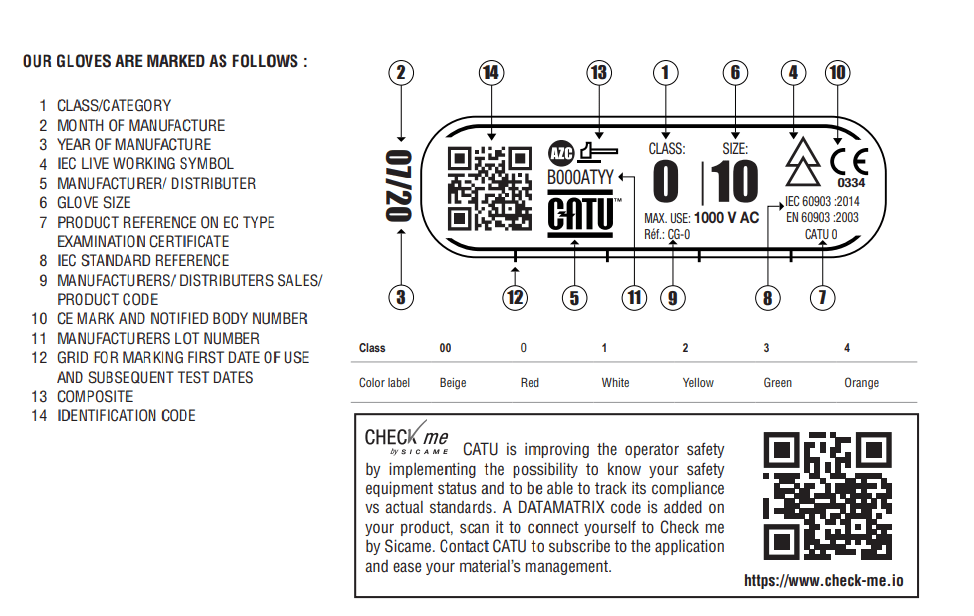Periodic Testing Of Electrician's Safety Gloves Classes 00, 0, 1, 2, 3 and 4
Improper use of rubber insulating gloves can be a matter of life and death. Get them retested regularly to make sure that they are still electrically safe. Treat your rubber gloves well and they can last a long time .
Boddingtons Electrical Ltd assets include a Phenix Technologies Glove Tester within our facilities.
Any Brand of Glove can be tested. Here are some examples.
- CATU
- Regeltex
- Honeywell Salisbury
- Polyco
- Clydesdale (Novax)
 |  |  |  |
Electrical Insulation Tests For Gloves Table 1
| Class Of Gloves
| Maximum Voltage Use AC DC | Test Voltage AC Proof | Test Voltage AC Withstand |
| 00 | 500V ac | 750V dc | 2.5kV | 5kV |
| 0 | 1000V ac | 1500V dc | 5kV | 10kV |
| 1 | 7500V ac | 11250V dc | 10kV | 20kV |
| 2 | 17000V ac | 25500V dc | 20kV | 30kV |
| 3 | 26500V ac | 39750V dc | 30kV | 40kV |
| 4 | 36000V ac | 54000V dc | 40kV | 50kV |
Special Properties Of Gloves Table 2
| Special Property Of Insulating Glove | Category Marking Code |
| Acid Resistance | A |
| Oil Resistance | H |
| Ozone Resistance | Z |
| Acid, Oil & Ozone Resistance | R |
| Extreme Low Temperature | C |
1 - Expiration date
Insulating rubber gloves have no expiry date and may be used as long as they comply with the periodic inspection.
2 - The periodic inspection
The most important date on the glove is date of manufacturer this is the key date for the period inspections and the recommend actions.
Class 00 and Class 0
- Verification regarding air leaks and a visual inspection
- However, a routine dielectric test may be performed at the owner's request.
Class 1, 2 , 3 and 4
- Verification regarding air leaks and and a visual inspection
- Verification via a dielectric test to verify electric properties
- We recommend gloves, in service to be re-tested every 6 months, since they we're first worn.
- We recommend gloves held in storage to be re-tested every 12 months


IEC 60903:2014 – A6:
The date of periodic retesting associated with a glove (by a marking or by other means) should be the date of current or next required inspection and dielectric test.
It is important that such marking does not affect the dielectric properties of the product. Any markings applied after manufacturing should not interfere with or replace the original markings.
3 - Field inspection and stock
Do not confuse the periodic inspection with the inspection before each use. Together with the periodic inspection, it is strongly recommended that a visual inspection of the gloves is carried out before each use. It is important to store the gloves in their UV-Resistant polythene bag and keep the gloves away from light, heat, and ozone. Ideally, the user should use our pneumatic tester to inflate the gloves for a good visual inspection and keep the gloves in our polypropylene store box for both transportation and storage.
4 - Special properties
Gloves that pass the special properties (acid, oïl, ozone, very low temperature) are not resistant to chemicals. The test is to guarantee electrical protection in case of accidental contacts. After completing the electrical work, it is recommended to replace the contaminated gloves.
We offer a periodic dielectric inspection service.
- On receipt of your gloves to our premises, the gloves and sleeves are documented and then washed and dried.
- They are then visually inspected by our technicians, using inflation equipment.
- The next stage is electrical testing. Test equipment is used and tests are carried out according to the correct voltage for the class of glove. After the electrical testing has been completed they are again inflated and visually inspected. The gloves are then stamped and packed for return.
- Documentation accompanies the gloves and sleeves through all stages of testing and any failures are recorded. Any glove that fails will be destroyed. If the customer wishes, failures can be replaced with new items from our stocks.

